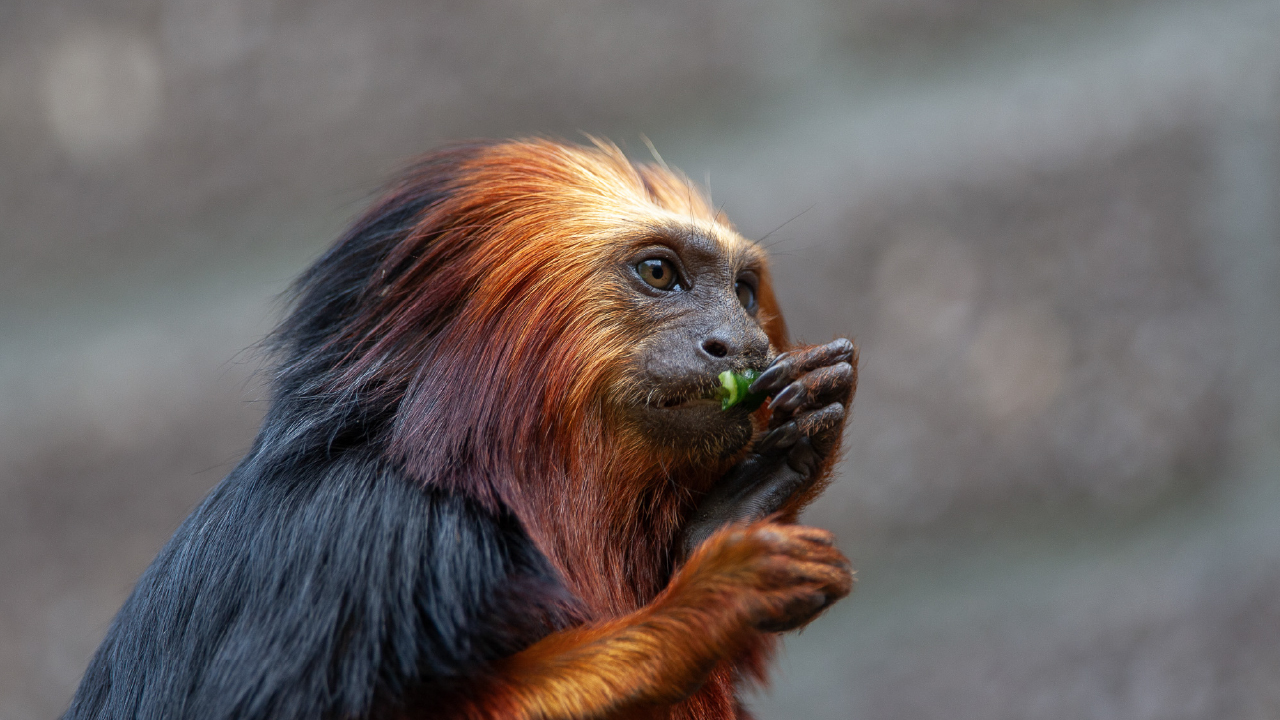Golden-Headed Lion Tamarin
Leontopithecus chrysomelas
Habitat
Lowland evergreen tropical rainforests and semi-deciduous forests
Food
Fruit, nectar and small prey
Weight
♂ ± 0,6 kg | ♀ ± 0,5 kg
Age
15 to 20 years
IUCN Status
Bedreigd
Appearance
The name gives you a clue: golden-headed lion tamarins have beautiful orange fur around their head and shoulders. It looks a bit like a lion’s mane. Their bodies are covered in black fur but their limbs are golden-coloured. They have claws instead of the flat nails most other primates have. This gives them a good grip on trees and branches when they climb. For this reason, golden-headed lion tamarins are also known as clawed monkeys. Golden-headed lion tamarins have olfactory glands on their chest and behind. They use these to let other animals know things like their location, what sex they are and whether they are ready to mate.
Habitat
Golden-headed lion tamarins live in the rainforests on Brazil’s east coast. They almost always live in the trees and very rarely come down to ground level because of all the dangers lurking there.
Lifestyle
Golden-headed lion tamarins live in small groups, consisting of two to eight (sometimes even fifteen) animals. There are often one to three adult males and one or two adult females in each group. The rest of the group is made up of juvenile animals.
Behaviour
Golden-headed lion tamarins communicate with each other using a variety of sounds. They also use scents to tell other animals things: they rub their olfactory glands against branches, for example, to deposit a scent. They usually spend one third of their day foraging. Golden-headed lion tamarins sometimes mix with other dwarf monkeys, especially in more open areas. They probably do this because a larger number of animals will spot danger more quickly, so this helps them to survive.
Reproduction
Golden-headed lion tamarins usually have twins once a year. Of course it is a major undertaking for a mother to raise so many young. Which is why the entire family helps to raise them, including father, brothers and sisters. Mind you, the parents are clearly in charge. When the oldest offspring are about three to four years old, they leave the group. They go off to find a partner to start their own family with. Thanks to the fact that they helped raise their brothers and sisters, they now know how to raise their own offspring!
Situation in the wild
In the wild, golden-headed lion tamarins are endangered. Their habitat is disappearing due to deforestation to make room for various forms of agriculture. Because this leaves fragmented sections of forest, the golden-headed lion tamarins have trouble finding each other and this can result in inbreeding.

Population-management programme
Apenheul is part of the EEP European population management programme for golden-headed lion tamarins. By working together with other international zoos, we maintain a genetically healthy population of golden-headed lion tamarins in captivity.
Fun facts
- Golden-headed lion tamarins are a species of dwarf monkey, all of which are famous for their striking ‘hairstyles’. In the case of golden-headed lion tamarins it is the beautiful hair around their head, which looks a bit like a lion’s mane.
- In total there are four species of lion tamarins: black-faced lion tamarins, black lion tamarins, golden lion tamarins and golden-headed lion tamarins. You can see the latter two at Apenheul!
Want to see the Golden-Headed Lion Tamarins at Apenheul?
Get your tickets now and roam freely among the primates!

Welcome to Apenheul
Open every day
from 10.00 until 17.00